Training Opportunities, Activities and Sports:

Basic Obedience is helpful in living with your Golden, or any dog. There are many programs that offer pet obedience classes. Puppy classes are also important if you’re planning on or have recently obtained a puppy.
Since there are no licensing requirements for dog trainers, be very careful in choosing your trainer and obedience school. Efforts have been made to try to improve the professionalism of dog trainers through development of professional organizations such as the American Pet Dog Trainers’ Association (APDT). APDT provides an independently administered and designed dog trainers’ test; those passing the test are listed with the APDT, although they also list members who have yet to take the test. APDT recommends positive training methods; positive methods often work better with the typically sensitive and trainable Golden.
To find an APDT trainer in your area go to their web site and look up listed trainers in your state. Those passing the APDT trainers’ test are listed as well. Large chain stores, like Pet Smart, require their trainers to pass the test and also to go through additional training.
There are other associations for professional dog trainers which you may find through web search engines. The key is to find a trainer with experience training. They should also have credentials such as membership in dog training professional organizations, and have competed and obtained obedience titles on their own and clients’ dogs.
After some basic obedience training you may want your Golden to earn his or her Canine Good Citizen (CGC). The AKC also offers a Canine Good Citizen program which, if your dog passes the CGC test, shows that your dog can politely walk on lead, be groomed, and is socialized, among other good pet behaviors.
For other activities you may want to enjoy with your Golden, read below. Links are highlighted.
Things you can do with your Golden. . .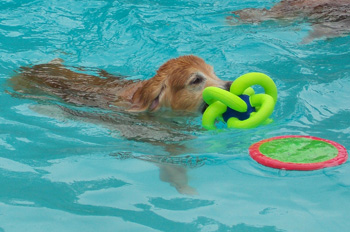
Will your dog become a hunting companion? A show dog? A field trial winner? An obedience dog? An agility dog? Therapy Dog? Cherished family pet?
We all hope that they are first a much loved family member. If you and they go on to do other things, terrific. However, if the only award they ever win is your love and affection, that’s the reward they prize most.
Below are some of the sports or activities you might consider.
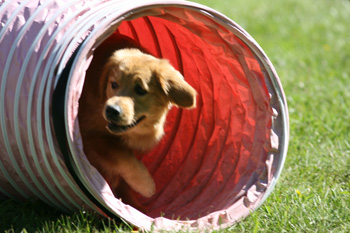 Agility: Agility is a sport in which a dog runs through a timed obstacle course under the guidance of the handler. Agility training strengthens your bond, and provides fun and exercise for you both. The obstacles include tunnels, jumps, seesaw, dog walk (a high plank across which a dog walks), an ‘A’ frame, a tire jump, chute, and weave poles. Basic titles earned at AKC agility trials are Novice Agility (NA), Novice JWW (NAJ), Open Agility (OA), Open JWW (OAJ), Agility Excellent (AX), Excellent JWW (AXJ), Master Agility Excellent (MX), Master Excellent JWW (MXJ), and Master Agility Champion (MACH). A web site called Clean Run also lists all agility organizations. Agility: Agility is a sport in which a dog runs through a timed obstacle course under the guidance of the handler. Agility training strengthens your bond, and provides fun and exercise for you both. The obstacles include tunnels, jumps, seesaw, dog walk (a high plank across which a dog walks), an ‘A’ frame, a tire jump, chute, and weave poles. Basic titles earned at AKC agility trials are Novice Agility (NA), Novice JWW (NAJ), Open Agility (OA), Open JWW (OAJ), Agility Excellent (AX), Excellent JWW (AXJ), Master Agility Excellent (MX), Master Excellent JWW (MXJ), and Master Agility Champion (MACH). A web site called Clean Run also lists all agility organizations.
Obedience Trials: Golden Retrievers excel in obedience. For example, of the Top 25 obedience dogs of 2006 listed by the AKC, 14 of the top 25 were Golden Retrievers (that’s 14 Goldens compared with the rest representing all other breeds of dogs!!) The AKC chose two Goldens to fill two of the three slots (the other was filled with a Border Collie) to represent the U.S. at the 2007 Crufts obedience competition in England.
 In obedience trials, you and your dog work as a team moving through a series of exercises from basic to advanced. There are three levels of obedience: the Novice (CD), the Open (CDX), and the Utility (UD). The top title is the OTCH, or obedience champion. Only the OTCH is won by competition with other dogs. In the titles, you and your dog compete against a standard. A perfect score is 200; you qualify if your score is above 170. In obedience trials, you and your dog work as a team moving through a series of exercises from basic to advanced. There are three levels of obedience: the Novice (CD), the Open (CDX), and the Utility (UD). The top title is the OTCH, or obedience champion. Only the OTCH is won by competition with other dogs. In the titles, you and your dog compete against a standard. A perfect score is 200; you qualify if your score is above 170.
In the Novice level the exercises include many that you would find useful for your pet to know such as heeling on lead and off, recall (come when called), sit, down, and stay. In the Open obedience level, these exercises continue but add retrieve (a dumbbell), retrieve over a jump, jump over a broad jump, and drop on recall (a safety exercise). For Utility obedience level, which is the highest level, there are also hand signal commands, directional jumping, directional retrieves, and scent discrimination.
Every dog should have at least some basic obedience instruction. Training can improve your relationship with your dog. Many people who start competitive obedience start by just taking the family dog to an obedience class and find that they both enjoy the sport.
Rally Obedience: It is a new sport with competition offered by U.S. organizations such as the American Kennel Club (AKC), and the American Pet Dog Trainers’ Association (APDT). Rally is a fun and exciting team sport for dogs and their handlers. Dog and handler teams navigate a course with numbered signs with each sign requesting that the team perform different exercises. Depending on the competition level the team performs such exercises as heeling around cones, about turns, 260 degree turns, Sit-Down-Sit, Straight Figure 8 around cones with distractions, Send Over Jump, Recall Over Jump. Teams navigate the course without direction from the judge. Handlers are encouraged to talk to their dogs during the performance. In the AKC held competitions, the title levels are Rally Novice, Rally Advanced, and Rally Excellent. Each level increases the degree of difficulty.
 Field: From the AKC description of Field Trials—today’s events often see multiple marked retrieves in excess of 250 yards and blind retrieves sometimes in excess of 300 yards. Today’s competitive All-Age Retriever must be in both excellent physical and mental condition, test in these trials almost always involve multiple marking test consisting of double, triple and quadruple marks with one, or several gun stations retired from the dogs sight, also single and multiple blinds are often involved. Field: From the AKC description of Field Trials—today’s events often see multiple marked retrieves in excess of 250 yards and blind retrieves sometimes in excess of 300 yards. Today’s competitive All-Age Retriever must be in both excellent physical and mental condition, test in these trials almost always involve multiple marking test consisting of double, triple and quadruple marks with one, or several gun stations retired from the dogs sight, also single and multiple blinds are often involved.
Most weekend retriever events are comprised of four events, two are major all-age events that carry championship points, and the other two are minor stakes for younger dogs. One of the following, open to professional trainers and amateur trainers, is offered, Open All-Age, Limited All-Age, Special All-Age, or Restricted All-Age, the determination as to which is offered is based on the entries at the clubs previous event. The other major stake, offered to Amateur handlers only, is Amateur All-Age, or Owner/Handler Amateur All-Age. At the previously mentioned stakes championship points are awarded, the awarding of these points count toward a dog’s Field Champion and Amateur Field Champion status.
Working Certificate: Working Certificate (WC) and Working Certificate Excellent (WCX) are titles are offered by the Golden Retriever Club of America. Their goal is to encourage owners of Golden Retrievers to use and maintain the natural hunting and retrieving abilities central to the breed.
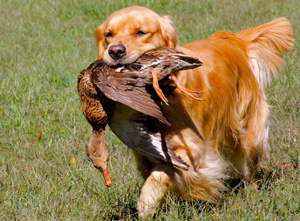 Not all Golden Retrievers will compete in field trials and therefore the GRCA devised simple land and water tests using ducks, game birds, or pigeons. These tests are designed to demonstrate the natural abilities of a retriever such as accurate marking and memory of falls, intelligence, attention, style, good nose, perseverance, desire and trainability. Not all Golden Retrievers will compete in field trials and therefore the GRCA devised simple land and water tests using ducks, game birds, or pigeons. These tests are designed to demonstrate the natural abilities of a retriever such as accurate marking and memory of falls, intelligence, attention, style, good nose, perseverance, desire and trainability.
The purpose of the Working Certificate Excellent test is to encourage the development of the Golden Retriever’s natural hunting and retrieving abilities through additional training. The WCX is designed to demonstrate the development of marking ability, memory, intelligence, perseverance and retrieving desire through training.
Tracking: A dog is “tracking” when he follows the scent trail left by a human being (or animal) that has passed along a certain route. Following a track is one of the many useful things dogs can do to help humans. Hounds track game, search and rescue dogs track lost children, police dogs track suspects, well-trained pets can find lost items. Many dog owners are involved in tracking with their dogs as a hobby (for fun) or as a sport (to earn titles), or both.
In the United States and Canada, tracking titles are offered by a variety of dog organizations, including the AKC. The AKC titles include the Tracking Dog title (TD), the Tracking Dog Excellent (TDX) and the Variable Surface Tracking (VST), leading to the Champion Tracker (CT) title. Tracking titles are earned by the dog successfully following a human scent laid down by a tracklayer on a track approved by two judges.
More Goldens than other breeds earn their tracking titles each year. To enter the TD test, you and your dog must certify with a tracking judge that you are ready for the TD test. To find more information and for tracking instruction, contact you local tracking club. In the Delaware Valley, the Lenape Tracking Club (not affiliated with LGRC) offers seminars and tracking classes. The Lackawanna Kennel Club also provides information.
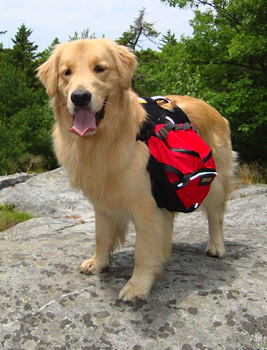 Search and Rescue: Search and rescue (SAR) dogs locate human scent that moves around on air currents, and follow that scent to its source—the victim. Dogs have a profound sense of smell, which humans help train the dog to use under different circumstances. Search and Rescue: Search and rescue (SAR) dogs locate human scent that moves around on air currents, and follow that scent to its source—the victim. Dogs have a profound sense of smell, which humans help train the dog to use under different circumstances.
SAR dogs are employed in a variety of emergency circumstances, such as, urban and wilderness settings to locate missing persons, in situations following a disaster such as earthquake or hurricane, and following avalanche or drowning incidents. SAR dogs are also used for cadaver search and evidence search. There are a number of groups dedicated to search and rescue. Some include the National Association for Search and Rescue, New Jersey Search and Rescue,and in the Lehigh Valley, North East Search and Rescue.
Freestyle: Canine Freestyle is a choreographed performance with music, illustrating the training and joyful relationship of a dog and handler team. The dog moves to the beat of the music and in relation to the handler. You will see graceful and intricate maneuvers performed with precision and artistry. Every movement is choreographed. Through the use of verbal cues and body language the dog moves with the handler. The emphasis is always on the dog, with the handler completing the team creating a harmonious whole. In some styles of freestyle, the dog can improvise as well. One organization is Canine Freestyle the other is the World Canine Freestyle Organization. To view a sample of freestyle, watch Carolyn Scott and Rookie on YouTube.
 Showing in Conformation: While often seen as a beauty contest of dogs, it really is a competition to see which dogs most closely resemble the Standard of the Breed. This competition was designed to identify those individuals that should be considered for inclusion in a breeding program. Most show dogs are competing for points toward their championship. To become an official AKC champion of record, a dog must earn a total of 15 points, which would include 2 major wins under 2 different judges. These points are awarded based on the number of dogs in actual competition—the more dogs, the more points. While many dogs are shown by professional handlers, you can be completely new to the dog world and still able to compete with the top in the “business” and win. (See the Golden Retriever standard under About Goldens in this site.) Showing in Conformation: While often seen as a beauty contest of dogs, it really is a competition to see which dogs most closely resemble the Standard of the Breed. This competition was designed to identify those individuals that should be considered for inclusion in a breeding program. Most show dogs are competing for points toward their championship. To become an official AKC champion of record, a dog must earn a total of 15 points, which would include 2 major wins under 2 different judges. These points are awarded based on the number of dogs in actual competition—the more dogs, the more points. While many dogs are shown by professional handlers, you can be completely new to the dog world and still able to compete with the top in the “business” and win. (See the Golden Retriever standard under About Goldens in this site.)
Flyball: Flyball is a relay race with four dogs on a team. The course consists of a starting line, four hurdles spaced 10 feet apart and a box. The first hurdle is 6 feet from the start line and the box is 15 feet from the last hurdle for a 51 foot overall length. The dogs jump the hurdles and steps on a spring loaded box that shoots out a tennis ball. The dog catches the tennis ball and then runs back over the four hurdles. When the dog crosses the starting line the next dog goes. The first team to have all four dogs run without errors wins the heat.
Skijoring: Skijoring is cross country skiing with one to three dogs tied to your waist. You wear a wide belt around your waist or hips and connect to the harness on your dog or dogs with a 3 to 4 meter long line that has a bungee cord built in to absorb the jerking. You ski, while the dogs run along in front pulling on the line. One can also do this at other times of the year while standing on a scooter.
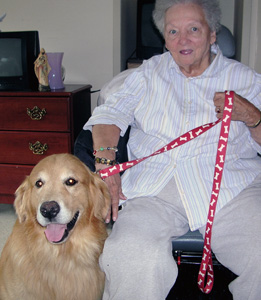 Therapy Dogs: Therapy Visiting Pets, Therapy Dogs, and Therapy Pets are just some of the names given to describe programs in which animals help people just by visiting with them. In other programs dogs help in physical rehabilitation in hospital settings. The benefits of interaction with pets are many. Medical studies suggest that blood pressure may be lowered and hospital stays shortened when patients have access to pets. In school settings, pets have been used to help reluctant readers become motivated readers merely by reading to nonjudgmental dogs. There are a number of organizations that offer therapy dog training and volunteer programs. One of these groups, Therapy Dogs International, provides tests and certification of therapy dogs. Therapy Dogs: Therapy Visiting Pets, Therapy Dogs, and Therapy Pets are just some of the names given to describe programs in which animals help people just by visiting with them. In other programs dogs help in physical rehabilitation in hospital settings. The benefits of interaction with pets are many. Medical studies suggest that blood pressure may be lowered and hospital stays shortened when patients have access to pets. In school settings, pets have been used to help reluctant readers become motivated readers merely by reading to nonjudgmental dogs. There are a number of organizations that offer therapy dog training and volunteer programs. One of these groups, Therapy Dogs International, provides tests and certification of therapy dogs.
|



 Agility: Agility is a sport in which a dog runs through a timed obstacle course under the guidance of the handler. Agility training strengthens your bond, and provides fun and exercise for you both. The obstacles include tunnels, jumps, seesaw, dog walk (a high plank across which a dog walks), an ‘A’ frame, a tire jump, chute, and weave poles. Basic titles earned at AKC agility trials are Novice Agility (NA), Novice JWW (NAJ), Open Agility (OA), Open JWW (OAJ), Agility Excellent (AX), Excellent JWW (AXJ), Master Agility Excellent (MX), Master Excellent JWW (MXJ), and Master Agility Champion (MACH). A web site called
Agility: Agility is a sport in which a dog runs through a timed obstacle course under the guidance of the handler. Agility training strengthens your bond, and provides fun and exercise for you both. The obstacles include tunnels, jumps, seesaw, dog walk (a high plank across which a dog walks), an ‘A’ frame, a tire jump, chute, and weave poles. Basic titles earned at AKC agility trials are Novice Agility (NA), Novice JWW (NAJ), Open Agility (OA), Open JWW (OAJ), Agility Excellent (AX), Excellent JWW (AXJ), Master Agility Excellent (MX), Master Excellent JWW (MXJ), and Master Agility Champion (MACH). A web site called  In obedience trials, you and your dog work as a team moving through a series of exercises from basic to advanced. There are three levels of obedience: the Novice (CD), the Open (CDX), and the Utility (UD). The top title is the OTCH, or obedience champion. Only the OTCH is won by competition with other dogs. In the titles, you and your dog compete against a standard. A perfect score is 200; you qualify if your score is above 170.
In obedience trials, you and your dog work as a team moving through a series of exercises from basic to advanced. There are three levels of obedience: the Novice (CD), the Open (CDX), and the Utility (UD). The top title is the OTCH, or obedience champion. Only the OTCH is won by competition with other dogs. In the titles, you and your dog compete against a standard. A perfect score is 200; you qualify if your score is above 170. Field: From the AKC description of Field Trials—today’s events often see multiple marked retrieves in excess of 250 yards and blind retrieves sometimes in excess of 300 yards. Today’s competitive All-Age Retriever must be in both excellent physical and mental condition, test in these trials almost always involve multiple marking test consisting of double, triple and quadruple marks with one, or several gun stations retired from the dogs sight, also single and multiple blinds are often involved.
Field: From the AKC description of Field Trials—today’s events often see multiple marked retrieves in excess of 250 yards and blind retrieves sometimes in excess of 300 yards. Today’s competitive All-Age Retriever must be in both excellent physical and mental condition, test in these trials almost always involve multiple marking test consisting of double, triple and quadruple marks with one, or several gun stations retired from the dogs sight, also single and multiple blinds are often involved. Not all Golden Retrievers will compete in field trials and therefore the GRCA devised simple land and water tests using ducks, game birds, or pigeons. These tests are designed to demonstrate the natural abilities of a retriever such as accurate marking and memory of falls, intelligence, attention, style, good nose, perseverance, desire and trainability.
Not all Golden Retrievers will compete in field trials and therefore the GRCA devised simple land and water tests using ducks, game birds, or pigeons. These tests are designed to demonstrate the natural abilities of a retriever such as accurate marking and memory of falls, intelligence, attention, style, good nose, perseverance, desire and trainability. Search and Rescue: Search and rescue (SAR) dogs locate human scent that moves around on air currents, and follow that scent to its source—the victim. Dogs have a profound sense of smell, which humans help train the dog to use under different circumstances.
Search and Rescue: Search and rescue (SAR) dogs locate human scent that moves around on air currents, and follow that scent to its source—the victim. Dogs have a profound sense of smell, which humans help train the dog to use under different circumstances. Showing in Conformation: While often seen as a beauty contest of dogs, it really is a competition to see which dogs most closely resemble the Standard of the Breed. This competition was designed to identify those individuals that should be considered for inclusion in a breeding program. Most show dogs are competing for points toward their championship. To become an official AKC champion of record, a dog must earn a total of 15 points, which would include 2 major wins under 2 different judges. These points are awarded based on the number of dogs in actual competition—the more dogs, the more points. While many dogs are shown by professional handlers, you can be completely new to the dog world and still able to compete with the top in the “business” and win. (See the Golden Retriever standard under About Goldens in this site.)
Showing in Conformation: While often seen as a beauty contest of dogs, it really is a competition to see which dogs most closely resemble the Standard of the Breed. This competition was designed to identify those individuals that should be considered for inclusion in a breeding program. Most show dogs are competing for points toward their championship. To become an official AKC champion of record, a dog must earn a total of 15 points, which would include 2 major wins under 2 different judges. These points are awarded based on the number of dogs in actual competition—the more dogs, the more points. While many dogs are shown by professional handlers, you can be completely new to the dog world and still able to compete with the top in the “business” and win. (See the Golden Retriever standard under About Goldens in this site.) Therapy Dogs: Therapy Visiting Pets, Therapy Dogs, and Therapy Pets are just some of the names given to describe programs in which animals help people just by visiting with them. In other programs dogs help in physical rehabilitation in hospital settings. The benefits of interaction with pets are many. Medical studies suggest that blood pressure may be lowered and hospital stays shortened when patients have access to pets. In school settings, pets have been used to help reluctant readers become motivated readers merely by reading to nonjudgmental dogs. There are a number of organizations that offer therapy dog training and volunteer programs. One of these groups,
Therapy Dogs: Therapy Visiting Pets, Therapy Dogs, and Therapy Pets are just some of the names given to describe programs in which animals help people just by visiting with them. In other programs dogs help in physical rehabilitation in hospital settings. The benefits of interaction with pets are many. Medical studies suggest that blood pressure may be lowered and hospital stays shortened when patients have access to pets. In school settings, pets have been used to help reluctant readers become motivated readers merely by reading to nonjudgmental dogs. There are a number of organizations that offer therapy dog training and volunteer programs. One of these groups, 